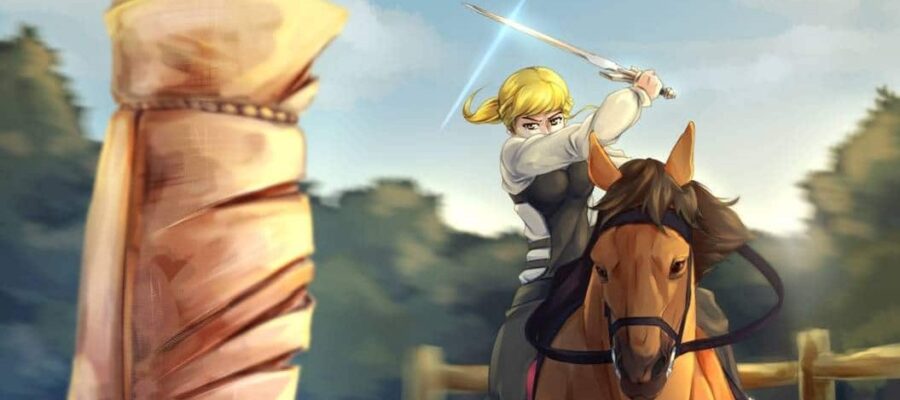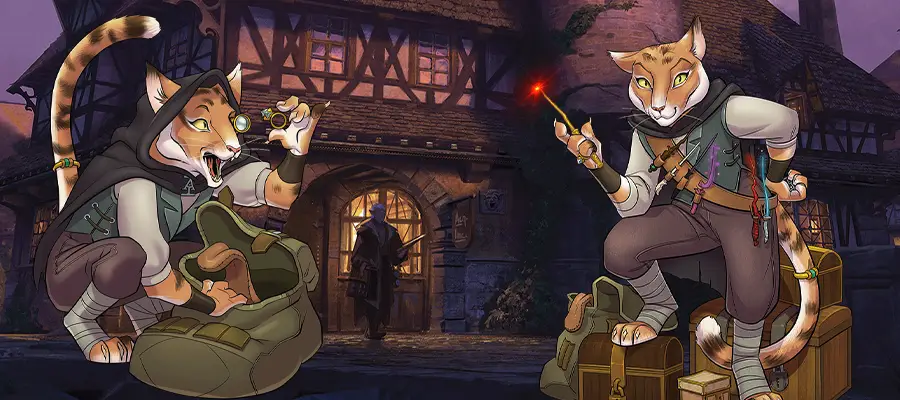“[Art Trade] Horseback Practice” by MrElementron-dA, Creative Commons Attribution-Share Alike 3.0 License
This article contains affiliate links that add gold to our coffers.
Premise
The concept of a Rogue that specializes in mounted combat seems compelling and fun to play. There is a bit of synergy between Rogues and mounted combat rules as well. Mounts deserve more attention in D&D because they’re so useful. Opal wrote an article about mounts and how they fit into D&D 5e; I recommend reading it. Her article makes me want to find ways to utilize mounts with my characters. But I’ll be adding my own thoughts today for trick riding Rogues!
Picture This
A woman on horseback suddenly emerges from the thick pine trees encircling the bandit camp. Weaving through bandits like a serpent between stones, she and her horse deftly dodge all would-be attacks as they approach their quarry. With blazing speed they reach a captive child that is tied up by the campfire. Keeping her feet secure in the saddle, she leans down to scoop up the captive child, followed by a getaway gallop that leaves the bandits wondering what just happened. Before the bandits can compose themselves, they notice their laundry line has been set ablaze as well. “Who the BLAZES was THAT? And why is my underwear on FIRE?”
If that doesn’t sound like a memorable night of D&D, I don’t know what does! Read on to learn about how you could create a character like this.
Horseback Rogue Game Mechanics
You’ll want to pick either the Folk Hero background or Soldier background to gain proficiency with vehicles (land). This will appease your DM who might want proficiency with land vehicles to enable your Rogue to ride mounts effectively. Proficiency with land vehicles will enable you to captain a variety of carriages, sleds, chariots, wagons, and more with your proficiency bonus added to any rolls to do so.
While you’re riding your mount and sharing initiative count with it, the mount can use the Disengage action to get you both out of trouble. This RPG Stackexchange forum sums up the concept of Disengaging while riding a mount. Think of it as the mount pulling you away, even though it’s your shared turn. If the mount Disengages, you’re good. If it doesn’t Disengage, the attackers will have the option to attack you or the mount per the mounted combat rules. Jeremy Crawford weighs in to back up this rule.
Mounts typically have movement speeds that exceed your own. The high movement speeds of mounts can enable you to kite melee combatants indefinitely since you can turn them into pin cushions with your shortbow while they never catch up to you. It’s also true that Rogues could potentially achieve this kiting strategy already with their Cunning Action, but I like the idea of using a mount to do it better. I never see people using mounts, especially Rogues; the uniqueness of this concept (Rogue that uses mounts) is part of the appeal to me.
Watch out for enemies who use the Ready action to prepare an attack for your horseback approach. After realizing that they can’t rely on opportunity attacks, enemies may decide that their best option is to Ready an attack. I point this out so you don’t assume you’ll be invincible against melee combatants.
Rogues receive the Reliable Talent feature at level 11, so make sure you are proficient with animal handling to help you with your taming, training, and riding of mountable creatures.
Should your Rogue happen to steal more than they can carry, a mount will be critical in making a getting away. Mounts can also pull carts and other assets that you may not have time to sift through. Lay a highway blockade to stop a caravan, then sneak in to hook up a cart to your own mount as you take off.
Though I mention horses, there is a variety of beasts and creatures that have the proper anatomy and size for riding. The Giant Owl, for example, would make an excellent mount with its flying speed coupled with its Flyby ability to avoid opportunity attacks. Research what kinds of beasts are in the Monster Manual to find which ones seem fun to you. Remember small creatures like Halflings and Gnomes can use mounts that are merely medium in size.
Mounted Combatant (Feat)
The Mounted Combatant feat will allow you to gain Sneak Attack as you attack unmounted creatures that are smaller than your mount. It also enables you to take attacks that would be made against your mount, with which you can use your reaction to halve the attack damage using your Uncanny Dodge.
Your mount will essentially share your Rogue Evasion feature, allowing you to take less-or-zero damage from effects that force AOE Dexterity saving throws. I like to picture the battlefield being lit up with a fireball, but the Rogue and its mount emerge from the flames unscathed as the Rogue brushes off the flames with a cloak and the horse gallops unshaken by the blast.
Subclass Choices
Rogues normally rely on the bonus action granted by Cunning Action to Disengage from enemies to get away. Riding a mount will allow you to retain your bonus action for other purposes because your mount can use its action to Disengage for the both of you. Let’s review the Rogue subclasses to identify which of them can best utilize a bonus action while riding a mount. Subclasses are referenced from the PHB and XGtE.
- Arcane Trickster: Clutch your spectral Mage Hand to your shoulder, then use your bonus action with your Versatile Trickster feature to distract a target as you attack. You could also cast interesting spells on yourself and/or your mount, such as Haste, Spider Climb, Longstrider, Fly, and Jump.
- Assassin: Not any mechanical synergy here other than the ability to approach quickly with a swift strike. It’s terrifying to be able to ride through a crowd to decapitate someone and get away before anyone reacts.
- Inquisitive: While not a common scenario, you could use your bonus action from horseback to search for hidden foes with your Eye for Detail feature. Additionally, your Insightful Fighting feature also uses your bonus action but with the possibility to gain advantage on attacks against a foe for one minute. Picture your Rogue on horseback surveying the battlefield to size up a formidable foe in order to strike against it.
- Mastermind: This subclass can benefit greatly from retaining its bonus action since its Master of Tactics feature allows it to use the Help action as a bonus action. This means you can stay mobile on the battlefield while acting like a proper general calling shots for your allies. Additionally, if you don’t feel particularly attached to your expendable mount (*gasp*), you may use your mount for cover in a fight. The cover would be extra useful due to the Mastermind’s Misdirection feature that allows you to redirect an attack targeting you to instead target another creature that is giving you cover.
- Scout: This subclass won’t have direct synergy with mounted combat until level 17 when it gains Sudden Strike. While the horse/mount Disengages and charges by enemies, a Scout can possibly gain advantage with the Mounted Combatant feat while striking multiple foes with Sneak Attack damage during the charge. Riding a mount also lends well to the Scout’s theme. Scouting requires quick travel to move information around quickly, and a mount can facilitate that need for speed without exhausting your Rogue. The additional proficiencies gained by Scouts will also help to play up the theme of an outdoorsy, horseback Rogue.
- Swashbuckler: While I do not detect synergies here, the Swashbuckler’s Elegant Maneuver feature could be fun for a trick riding character. Elegant Maneuver would grant advantage to an acrobatic display for a crowd or for battlefield taunting.
- Thief: I really like this one. Since a Thief Rogue can use their Cunning Action with Fast Hands to attempt a Sleight of Hand check or a Use an Object action with their bonus action. I picture a scene out of a Looney Tunes cartoon where a horseman rides past a man, resulting in the removal of all the man’s possessions, including clothes down to his underwear. The Thief could also use Alchemist’s Fire or Acid as their bonus action as they commit a driveby. You could also use a healer’s kit to quickly patch someone up and stabilize them as a bonus action, then get out of the fray without risking you or your mount’s wellbeing. I don’t believe this would work with the Healer feat to restore hitpoints because that feat gives you an action that happens to use the healer’s kit, as opposed to Use an Object action that would normally apply to a healer’s kit for stabilizing a character.
Conclusion
Mounts aren’t just for jousting knights or arrow slinging rangers. Rogues can use mounts in so many ways that are interesting to me. Though it can be annoying for some players to deal with animal companions due to their cost of upkeep and proneness to perish, mountable beasts can completely transform how you play a character. Players struggling to roleplay with their peers may have an easier time roleplaying with an animal companion like a mount. Make sure your DM knows you want to treat a mount like family so the DM hesitates to just kill it off unceremoniously. I look forward to trying this concept myself sometime, and I hope you do too.
Have you already tried playing as a Rogue that rides horseback? What other mount ideas do you have, and which ones have you tried before? I’m eager to know what you think of this horseback Rogue concept and any concepts you have. Please cast Message on us in the comments section below to share your thoughts.
We’ll keep bringing the weekly content to you, so please bookmark us to memorize our teleportation circle so you can return frequently. Check out our other articles if you enjoy a Heroes’ Feast of D&D content (including Opal’s D&D mount article that I mentioned earlier).
This is Flutes wishing you a happy adventure. Thanks for visiting!





You sold me on an Arcane Trickster Rider with the concept of an all terrain mount.
As Mr. Burns would say, “Exxxxcellent…” 🙂